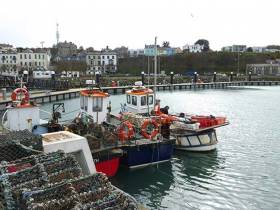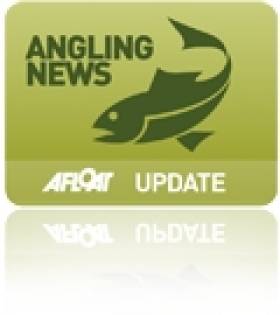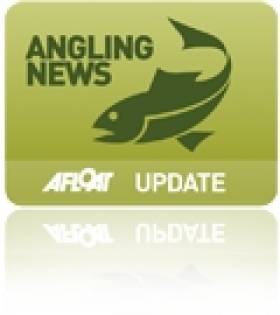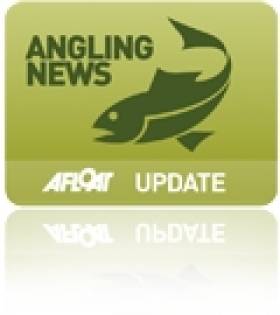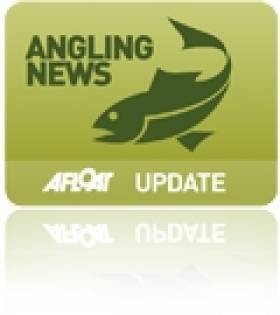Displaying items by tag: Fishery
EU Fisheries Commissioner Sinkevičius Visits Killybegs Fishery Harbour Centre & Meets Irish Fishing Industry representatives
EU Commissioner for Environment, Oceans and Fisheries Virginijus Sinkevičius yesterday accompanied Minister Charlie Mc Conalogue T.D. on a visit to Killybegs Fishery Harbour Centre, as part of his two-day visit to Ireland.
Minister for Agriculture, Food and the Marine Charlie McConalogue, T.D., invited the Commissioner to come to Killybegs to meet with fishing industry representatives and see at first hand the activity in one of Ireland’s biggest fishery harbours and to discuss the significant EU related issues of concern to the Irish Fishing Industry.
As Afloat reported earlier, the Commissioner, accompanied by Minister McConalogue, met with representatives of all of the major Irish fishing industry organisations. Representatives from Irish South & West Fish Producers Organisation, Irish South & East Fish Producers Organisation, Killybegs Fishermen’s Organisation, Irish Fish Producers Organisation, Irish Islands Marine Resource Organisation, Irish Fish Processors and Exporters Association and National Inshore Fisheries Forums all attended the meeting with the Minister and the Commissioner.
Whilst in Killybegs, Commissioner Sinkevicius had the opportunity to view fish being landed by a pelagic vessel at the Fishery Harbour Centre.
Minister McConalogue said: “I am very pleased to welcome Commissioner Sinkevičius on his first official visit to Ireland. I’d also like to thank our industry representatives for their positive engagement today. The last year and a half has been a challenge for us all. Ireland’s Seafood Sector has been among the most seriously impacted by BREXIT. This meeting allowed industry to set down clearly for the Commissioner the challenges they continue to face and identify opportunities that will help to rebuild and support a robust sector in the future. It is more important than ever to work together to restore the confidence of the industry and to ensure that every opportunity is pursued so that we build a sustainable future for our industry and the coastal communities which depend on it.”
The Commissioner will also visit a FLAG funded project at Cooley Oysters Ltd in Carlingford County Louth, as part of his visit.
Naval Service Bonus As It Takes on More Foreign-Born Recruits
#navy - Increasingly the Naval Service is taking on more foreign-born recruits, which is a bonus when it comes to dealing with trawlers fishing off the coast that hail from a number of different countries.
As the Irish Eaminer writes, the latest foreign-born recruit to join up is Krzysztof Mendel, 18, who was born in Mragowo in Poland.
As a very young man he moved to Kilmacrenan, County Donegal and was inspired to join the military by his father who served in the Polish Army.
Krzysztof has joined the ranks which already feature a number of Poles and other Eastern Europeans.
A Naval Service spokesman said many of these recruits are fluent in several languages and this comes in very useful when they are on fishery patrols and have to communicate with foreign vessels.
More the story by clicking here.
Ireland’s Six Fishery Harbour Centres & Small Harbours Get €28m In Funding For Capital Projects
The Minister for Agriculture, Food and the Marine, Michael Creed TD, today announced details of a €28m Capital Investment Package for the ongoing development of Ireland’s Local Authority owned small harbour network. (see Table 1 below for details)
In announcing the initiative the Minister said “The €28m I am allocating for the 2017 Fishery Harbour and Coastal Infrastructure Capital Programme represents a significantly increased capital investment in the six Fishery Harbour Centres and other fisheries related marine infrastructure. It is testament not only to this Governments ongoing commitment to the Seafood sector, but also to the success of the sector in terms of increased activity levels.”
The Annual Fishery Harbour and Coastal Infrastructure Capital Programme provides funding for development works, safety and maintenance at the six Fishery Harbour Centres at Howth, Dunmore East, Castletownbere, Dingle, Ros an Mhil and Killybegs. The primary function of the Fishery Harbour Centres is to underpin the ongoing development of the fisheries and seafood processing sectors, while also facilitating other diverse marine related activities. The annual value of all fish landings into the six Fishery Harbour Centres increased from €136.8m to €262.3m over the period from 2010 to 2015.
The Minister said “I have set aside almost €25.5m towards development works, safety and maintenance at the six Fishery Harbour Centres which account for around 85% of all fish landed into Ireland. I have also proved €2.5m for a Local Authority Harbour Development and Marine Leisure programme to assist coastal Local Authorities in the repair and development of small scale piers, harbours and slipways under their ownership.”
Flagship projects in the 2017 Capital Programme include major quay extensions at Castletownbere, Killybegs, and Howth. Also of note is the dredging of the navigation channel in Dingle, the completion of the Small Craft Harbour in Ros an Mhíl and the West Wharf upgrade in Dunmore East.
The Minister concluded by saying “This €28m investment will build on the €64m invested in the Fishery Harbour Centres since 2010 and the €23m invested in the Local Authority infrastructure over the same period. It continues to improve the facilities at our Fishery Harbour Centres and other public harbours around our coast attracting increasing and additional economic activities, benefitting a broad cohort of current and future harbour users including the fishing industry, seafood processing sector, other ancillary marine industries, and the wider rural coastal communities”.
Table 1- Fishery Harbour & Coastal Infrastructure Development Programme 2017
| Table 1. | ||||
| Location | Project Description | Cost €m | ||
|
Howth:- |
Construction of additional berthing face to middle pier and dredging along pier face. Gas Main Other Services (Sewers, ducting, watermains) Claremount Storage Units East Pier Repairs Syncrolift – Timber Deck Footpath Upgrade |
1.50 0.15 0.15 0.15 0.17 0.05 0.15 |
||
| Total | 2.32 | |||
|
Dunmore East:- |
West wharf upgrade required due to steel corrosion and spalling of concrete. Shanoon Car Park |
0.4 0.2 |
||
| Total | 0.6 | |||
|
Castletownbere:- |
Dinish island pier extension New Harbour Administration Building (shared facility) on mainland Quay. Harbour Slipway |
5.0 1.2 0.3 |
||
| Total | 6.5 | |||
|
Dingle:- |
Dredging North Channel to widen the navigation channel to the port and provide better access. Upgrade of Harbour Marine Facilities Building |
4.0 0.2 |
||
| Total | 4.2 | |||
|
Ros an Mhíl:- |
Small Craft Harbour final Phase (furniture fit out and services). |
0.8 |
||
| Total | 0.8 | |||
|
Killybegs:- |
Smooth point pier extension and permitting. Harbour Electrics Upgrade Small Craft Harbour final completion. |
5.0 0.5 0.7 |
||
| Total | 6.2 | |||
| Total Fishery Harbour Centres( new developments) | 20.62 | |||
| Cape Clear | Complete development works incl painting stoplogs, install pontoons, finish road works. | 0.1 | ||
| Safety and Maintenance and Non-Discretionary and Contractual Capital Commitments (incl Disability Access) | 4.69 | |||
| Total Local Authority Harbour Development and Marine Leisure Programme | 2.50 | |||
| Total 2017 Fishery Harbour and Coastal Infrastructure Capital Programme | 27.91 | |||
€18m in Fishery Harbour Works Announced
Pontoons in Cape Clear, West Cork a small craft harbour in Killybegs, County Donegal and dredging works in Howth, County Dublin are part of an €18m Capital Investment Package in 2016 for the development of Ireland’s fishery harbour network announced today by Minister for Agriculture, Food and the Marine, Simon Coveney T.D. See the full table below.
Announcing the investment package, the Minister said “In total I am allocating €18m for this year's Fishery Harbour and Coastal Infrastructure Capital Programme. I have set aside €16m towards safety, maintenance and new development works at the six Fishery Harbour Centres at Howth, Dunmore East, Castletownbere, Dingle, Rossaveel and Killybegs. I am also making €2m available for a Local Authority Harbour Programme, and I am assessing specifically what is required to address storm damage at Local Authority owned fishery harbours.”
Flagship projects in the 2016 Capital Programme (see table1) include the provision of dedicated Ferry pontoons on the West Pier in Howth, infrastructure upgrades in Dunmore East, commencement of the Dinish Wharf expansion Project in Castletownbere, expansion of the small craft harbour in Ros an Mhíl and the Smooth Point pier extension in Killybegs. The Minister continued, “While there are a number of flagship projects for completion this year, of equal importance is the preparatory work for significant potential projects in Howth, Dunmore East, An Daingean and Ros an Mhíl”
The 2016 Fishery Harbour and Coastal Infrastructure Capital Programme outlined by the Minister also contains funding of €2m to assist coastal Local Authorities repair, maintain and develop piers, harbours and slipways under their ownership. The Minister stated “I am delighted to continue to support Local Authorities in their efforts to maintain and develop the fishery harbour network which provides much needed facilities for our rural fishing and marine focussed communities. A number of smaller fishing piers around the coast experienced some damage during the recent storms and we are currently assessing how best to assist Local Authorities in carrying out repairs”
Concluding on the 2016 Fishery Harbour and Coastal Infrastructure Capital Programme, the Minister said “This year’s programme is significant on a number of fronts, firstly it provides for the continuation of this Governments strategy to develop and improve the facilities at our fishery harbours in 2016. Secondly it prepares the groundwork for potential projects in the coming years all of which will benefit the fishing industry, seafood processing sector, other ancillary marine industries.”
Table 1- Fishery Harbour & Coastal Infrastructure Development Programme 2016
| Location | Project | Cost €m |
|
Howth: |
- Traffic Management Works - East Pier Repairs - Pontoons to west pier for ferry landings - Engineers office - Preparation of Dumping at Sea licence - Provision of Berthing Face to Middle Pier - Electric Works West Pier - Gas Main - Other Services (Sewers,ducting,watermains) Total |
0.150 0.050 0.400 0.050 0.100 0.100 0.300 0.150 0.150 1.450 |
|
Dunmore East: |
- Harbour Office Upgrade - West Wharf upgrade - Breakwater (Design Report) - Harbour Road re-surface Total |
0.700 0.200 0.160 0.100 1.160 |
| Castletownbere: |
- Harbour User toilet and Shower facilities - Dinish Wharf Expansion - Harbour Slipway - Quayside Electrical Upgrade - Harbour Offices Upgrade - Replacement of water network Dinish - Dinish Bridge Survey - CCTV Total |
0.090 1.000 0.040 0.150 0.250 0. 450 0.080 0.070 2.130 |
|
An Daingean:
|
- Workshop Design ,Planning and commence works - Capital Dredging Navigation Channel – Dumping at sea Licence, tender preparation and preparation works - Net mending area Total |
0.400 0.500 0.100 1.000 |
|
Ros an Mhíl:
|
- Quay Development – Design, Evaluations, Consulting, EIS, Permitting and preparation works - Small craft Harbour – Dredging Total |
0.800 1.800 2.600 |
|
Killybegs:
|
- Repairs to Blackrock/Auction Hall Piers - Small Craft Harbour - Smooth Point Pier Development - Landing Pier Fendering - Landing Pier Electrical Design/Works - Boatyard investment Total |
0.175 0.900 2.500 0.300 0.190 0.0 70 4.135 |
|
Cape Clear
|
-Pontoons Total |
400 0.400 |
| Total Departmental Owned Marine Infrastructure projects | €12.875 | |
| Safety and Maintenance and Non-Discretionary and Contractual Capital Commitments 2016 (incl Disability Access) | €3.120 | |
| Total Local Authority Harbour Development and Marine Leisure | €2.000 | |
| Total Fishery Harbour and Coastal Infrastructure Capital Programme |
€17.995
|
|
The Minister for Agriculture, Food and the Marine, Simon Coveney TD, today announced the full details of a €17.8m Capital Investment Package for the ongoing development of Ireland's publicly owned fishery harbours and local harbour network .
In announcing the initiative the Minister said "I am delighted to announce the full details of my Departments €17.8m Fishery Harbour and Coastal Infrastructure Capital Programme for 2015. I have set aside €14.9m towards safety, maintenance and new development works at the six Fishery Harbour Centres at Howth, Dunmore East, Castletownbere, Dingle, Rossaveel and Killybegs, in addition to the completion of infrastructural improvement and storm damage repair works at North Harbour, Cape Clear which is also owned by my Department."
Flagship projects in the 2015 Capital Programme (see table1) include major dredging works at Dunmore East, the provision of small craft harbours and pontoons in Howth, Rossaveal and Killybegs, electrical upgrading in Castletownbere, and necessary remedial works to the main pier in Dingle. In addition, the Bull Nose Development and the Duffy's Pier storm damage repair projects at North Harbour Cape Clear are to be completed.
The Minister went on to say "I have also allocated €1.5m for a Local Authority Harbour Development and Marine Leisure programme in 2015, and as an exceptional measure I am also providing in the region of €1.4m to facilitate the completion of a number of Local Authority Storm Damage projects which were approved in 2014 as part of the Governments response to the extreme weather conditions in late 2013 and early 2014, but not completed by the Local Authorities in 2014 due to time constraints and other issues. My Department will be contacting the Local authorities regarding these schemes shortly."
The Minister concluded by saying "This is a significant level of investment in Ireland's publicly owned fisheries and local harbour network. It will continue the implementation of the Governments strategy to develop and improve the facilities at our Fishery Harbour Centres and other public harbours around our coast, benefitting a broad cohort of stakeholders including the fishing industry, seafood processing sector, other ancillary marine industries, marine tourism and leisure and the wider rural coastal communities".
Table 1- Fishery Harbour & Coastal Infrastructure Development Programme 2015
|
Location |
Project |
Department Approved Funding |
|
|
Cape Clear, Co. Cork. |
Bull Nose Development |
€900,000 |
|
|
Duffy’s Pier |
€900,000 |
||
|
Safety & Maintenance Works |
€50,000 |
||
|
Disability Access Works |
€10,000 |
||
|
Piers, Lights & Beacons |
€136,000 |
||
|
All Fishery Harbour Centres |
Safety and Maintenance |
€1,440,000 |
|
|
Howth FHC |
Traffic Management Works |
€75,000 |
|
|
Provision of Small Craft Pontoon |
€1,000,000 |
||
|
Site investigation for West Pier pontoon and Middle Pier upgrade |
€150,000 |
||
|
Upgrading Electrical System – Phase 3 |
€150,000 |
||
|
Castletownbere FHC |
Power points & Electrical Upgrade |
€350,000 |
|
|
Sanitary Facilities Works |
€90,000 |
||
|
Harbour Slipway – Phase 1 |
€400,000 |
||
|
Replacement of Water Network – Dinish Island- design |
€20,000 |
||
|
Proposed Development South Side – Dinish Island- site investigation |
€30,000 |
||
|
An Daingean FHC |
Navigation Buoys Replacement |
€130,000 |
|
|
Main Pier sheet pile Remedial Works |
€200,000 |
||
|
Harbour Workshop and Marina Users Facilities Building - Design |
€40,000 |
||
|
Upgrade Harbour Entrance |
€150,000 |
||
|
Rossaveel FHC |
Phase 2 Small Craft Harbour |
€700,000 |
|
|
Construction of New Slipway – Design Phase |
€70,000 |
||
|
Dunmore East FHC |
Harbour Office Upgrade – Phase 2 |
€200,000 |
|
|
Breakwater design |
€150,000 |
||
|
Traffic Management Plan |
€15,000 |
||
|
Dredging Works |
€6,500,000 |
||
|
Killybegs FHC |
Improvement works to Shipyard Entrances |
€40,000 |
|
|
Small Craft Harbour – Phase 2 |
€700,000 |
||
|
Provision of additional bollards |
€60,000 |
||
|
Smooth Point Pier Extension – studies and preparation: |
€175,000 |
||
|
Power Outlets - Boatyard |
€40,000 |
||
|
Local Authority |
Local Authority Harbour Development and Marine Leisure |
€1,500,000 |
|
|
Local Authority Storm Damage |
€1,400,000 |
||
Salmon & Sea Trout Fishery Stocks Improve in Letterkenny Fisheries
Mr. Joe McHugh T.D., Minister of State at the Department of Communications, Energy and Natural Resources, has approved a suite of regulations and bye-laws that will govern the wild salmon and sea trout fisheries in 2015. These will come into effect from Thursday 1 January 2015.
Minister Mc Hugh highlighted the progress made in relation to two Rivers in the Letterkenny Fishery District.
The Minister said, "major angling development works are already underway to enhance the highly scenic River Lackagh as a salmon and sea trout fishery. In the latest annual scientific assessment the Lackagh remains open to catch and release angling for 2015 but the deficit in the salmon stock has moved significantly closer to the Rivers conservation limit which once surpassed will facilitate a full opening of the fishery"
"The partnership approach between the Creeslough Angling Club, and Inland Fisheries Ireland (IFI) in a joint management plan for the fishery is making real progress. Salmon numbers have improved steadily on the fishery in recent years with the fishery re-opened on a 'catch and release' basis for the past two seasons. The key issue is to bring the River above its conservation limit and to build on the good work to date. This will require continued collaboration and maintaining patience for the future good of the fishery – it's about staying the course", he added
The Minister recently visited the River to view for himself significant upgrades to facilities along the lower reaches of the river near Creeslough village. The majority of the work was carried out by TUS workers, with materials and additional labour supplied by IFI. The salmon Conservation Fund administered by IFI, has already funded a series of enhancement measures and work in ongoing to secure a major capital project for the fishery next year to install a crump weir and fish counter.
"This is real partnership in the Community with the local club working side by side with the State Agency to enhance their river and its fishery" said Minister Mc Hugh. "The club deserves great praise for its efforts and its forbearance, as do IFI for their excellent support, while we wait for the recovery in salmon numbers to hopefully continue its upward curve" he added.
The Minister also noted the improved stock status in the River Leannan which has moved from being completely closed in 2014 to being open for catch and release angling for 2015. The improved status will allow anglers to catch fish and thereby provide a useful index of salmon numbers in the river before releasing the fish to bolster spawning.
Minister Mc Hugh said, "this is also god news for the Leannan in that it is also moving in the right direction, however all concerned anglers and IFI must nurture this new status and continue to contribute towards building on improvements in the salmon numbers". "While this is a positive development, what the Leannan needs now is again a sense of restraint and a resolution from all stakeholders to ensure that forward movement is maintained" he added.
Salmon Surplus Sure to Attract Anglers to Lough Melvin
#Angling - Anglers on both sides of the border will be looking forward to a salmon bonanza on Lough Melvin when it opens for fishing on Friday 1 February, according to the Impartial Reporter.
The Fermanagh lake has been bucking the trend of declining fish stocks in Northern Ireland's inland waterways, which have prompted concerns that the species has been reduced to 'dodo levels'.
Despite the news last October that just three out of every 100 wild salmon returned to Northern Ireland's rivers in 2011, fishery experts believe that Lough Melvin and the River Downes that connects it to the sea have a surplus of salmon - providing valuable sport (and dinner) for angling locals and tourists alike.
Even so, anglers in both jurisdictions of the border-straddling fishery will have to abide by their respective legislation, which provides for a strict tagging and recording system.
On the Northern Ireland side, anglers are issued one tag at a time up to a total of three for the first three months of the season, with a maximum of 10 issued for any single angler on Lough Melvin by the close of fishing on 30 September.
The Impartial Reporter has much more on the story HERE.
Minister Opens White River Fishery Enhancement Project
#ANGLING - Minister of State Fergus O'Dowd was on hand at the opening of the White River enhancement project in Dunleer, Co Louth earlier this month.
The €32,000 project was funded by the Louth Leader Partnership, with works were carried out by the Dee and Glyde Fishing Development Association and the Dundalk district staff of Inland Fisheries Ireland.
The White River, a tributary of the River Dee, is considered hugely important as a spawning and nursery area, and it has already seen significant improvements in the levels of juvenile salmon and trout.
Instream enhancement works began in 2006, supervised by Inland Fisheries Ireland, and included the introduction of new gravel, weirs, deflectors and spawning beds which have helped the White River to achieve its potential in terms of fish numbers.
Speaking at the launch, Inland Fisheries Ireland CEO Dr Ciaran Byrne said: "The work that I have seen on the river is fantastic and a credit to all involved."
IFI assistant inspector in Dundalk, Ronan O’Brien, said project was based on restoring the natural features of the river.
He added that the programme was a great recognition of the work carried out by the Dee and Glyde Fishing Association, and that it had strengthened links with local business and development groups and could be used as a template for other projects in the area.
#ANGLING - The 30-day public consultation on new regulations for the management of the 2012 wild salmon and sea trout fishery will expire next Thursday, The Irish Times reports.
The new regulations are based on advice from Inland Fisheries Ireland following an assessment of 141 rivers nationwide by the Salmon Standing Scientific Committee.
That assessment recommended that that 43 rivers should open (seven fewer than in 2011); 34 rivers should open for catch-and-release (six more than 2011); and 64 rivers should be closed (one fewer than 2011).
New conservation rules include bag limit for sea trout and a restriction on angling for other species when fishing for salmon on closed rivers.
The Irish Times has more on the story HERE.
Bumper Catch at Rock House Fishery
Described by The Irish Times' Derek Evans as "one of the Great Fishing Houses of Ireland", the Rock House fishery in Co Mayo boasted banner numbers of salmon and sea trout catches this spring and summer.
April started off strong on the Owenduff River in Ballycroy, with three spring salmon weighing between 9.5lb and 12lb landed in the first two weeks.
This was followed by respectable numbers in May of 30 salmon and three sea trout. But June and July were the bumper time for angling, with thundery rain aiding the catch.
Even August proved bountiful despite lacking in fresh grilse, with 12 salmon ad 27 sea trout caught throughout the month.
"Drift netting laws appear to be having a positive effect," said Rock House's Sibylle Geffroy.
The Irish Times has more on the story HERE.



























